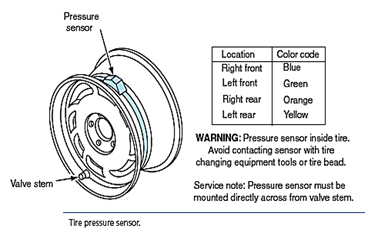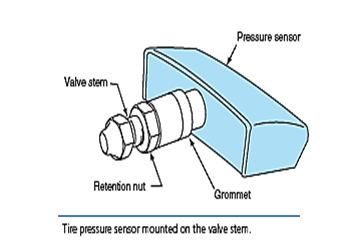←
Automobile Engineering
Tire Pressure Monitoring Systems
Introduction:
A tire pressure monitoring system illuminates a warning light in the instrument panel to inform the driver if one tire has low pressure; some systems also alert the driver if tire temperature is excessive.
Tire pressure sensor:

- Some tire pressure monitoring systems have a sensor strapped in the drop well on each rim.
- These sensors must be mounted on the rim directly opposite to the valve stem. Other tire pressure monitoring systems have a sensor mounted on top of each valve stem in place of the valve cap.
- Regardless of the sensor’s mounting location, it transmits radio frequency (RF) signals. These RF signals will change if any tire is underinflated a specific amount.
- The RF signals are sent to a receiver that is usually mounted under the dash.
- On some systems the receiver illuminates the low tire pressure warning light in the instrument panel if the pressure in any tire drops below 25 psi (172 kPa).
- On other systems the tire pressure warning light is illuminated with a smaller reduction in tire pressure.
Tire Pressure Monitoring Systems (TPMS) with Valve Stem Sensors

- Most current TPMS have pressure sensor that are attached to the valve stem inside the tire, and these sensors require a battery. Average battery life is approximately 10 years.
- A retention nut is threaded onto the valve stem on the outside of the wheel rim, and a sealing grommet is positioned between this nut and the rim.
- The internal threads on the retention nut are positioned near the bottom of the nut, and matching threads are located near the bottom end of the valve stem.
- A nickel-plated valve core is threaded into the internal threads in the valve stem, and a special valve cap is threaded onto the external threads at the top of the valve stem.
TPMS with Electronic Vehicle Information Center (EVIC) Display
- Some TPMS provide graphic tire pressure displays and warning messages on an EVIC display in the instrument panel. These systems may have 4-tire or 5-tire monitoring capabilities.
- A TPMS with 5-tire monitoring capabilities also monitors the spare tire. These systems have valve stem sensors that broadcast tire pressure once per minute when the vehicle is moving at 25 mph (40 km/h) or faster.
- If the vehicle has a 5-tire TPMS, the sensor in the spare tire transmits a signal every hour. Each valve stem sensor transmits a unique code so the EVIC module can determine the location of the sensor.
- This type of TPMS provides a warning display in the EVIC if the tire pressure drops below a specific value or increases above a certain threshold.